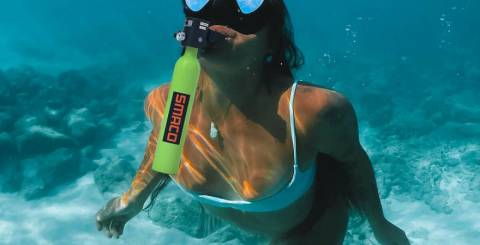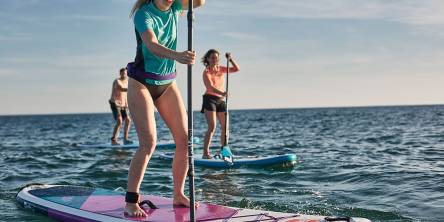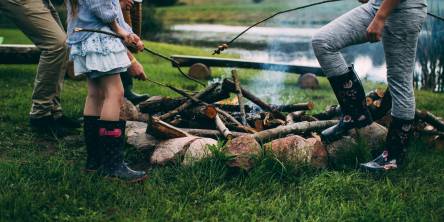How Long Does a Mini Scuba Tank Last?

An open-water certified scuba diver using a standard aluminum 60/80-cubic-foot tank and doing a dive at a depth of 40 feet may expect to remain under for around 45 to 60 minutes before ascending to the surface with a sufficient amount of air in the tank for a safety reserve.
Three factors play a role in determining how much air a diver will have left.
Tank Volume
The aluminum 80 is one of the most used recreational diving tanks. It has a capacity of 80 cubic feet and can compress the air to a pressure of 3000 pounds per square inch (PSI). On the other hand, diving tanks may be purchased in various materials and sizes to accommodate a wide range of uses.
Divers who often participate in extremely deep or lengthy dives can find that tanks with a larger internal capacity are more comfortable. Divers who are short and utilize relatively little air when diving may find smaller tanks more comfortable. If all else remains the same, a tank that can store more air for a more extended period will be able to stay submerged for longer.
Depth
When a scuba diver goes deeper into the water, the air pressure around him becomes higher. This rise in force does not affect the air that is already compressed to a very high pressure inside of the diver's scuba tank since the scuba tank is a rigid container and the air inside of it is already compressed to a very high pressure.
Nevertheless, the air that leaves the tank and travels through the scuba diver's regulator hoses and second stages is compressed as a result of the pressure of the water. For example, the amount of air that can fit into a space is one cubic foot, while the surface can only fit into an area that is 0.5 cubic feet when at a depth of 33 feet, owing to the compression that occurs when water is present.
Similarly, a diver will use double the amount of air at a depth of 33 feet compared to what he would use at the surface. To put it another way, a diver will deplete the stand in his tank faster the deeper he descends into the water.
The rate of air consumption
The pace at which a diver uses up air will decide how much longer the stand in his tank will continue to be advantageous compared to that of an ordinary diver. A diver with an enormous lung capacity will need more air than a petite or short person with a smaller lung volume and will often have a higher air consumption rate.
The larger lung volume will allow the diver to take in more oxygen. Stress, degree of expertise, level of buoyancy control, and the amount of energy necessary for the dive are all elements that impact an individual's overall air consumption rate. Breathing that is relaxed, leisurely, and deep is often the most effective method for a diver to lower the air consumption rate.
A diver must often finish his dive before reaching the limit of his air supply since this is often the limiting factor. Both the dive plans and the dive locations might change. It is not necessary for a diver to remain submerged until there is no more air in his tank, nor does it necessarily guarantee that he will desire to do so even if he can.
In the end, the amount of time that a specific person and dive will get out of the air in a tank depends on several different elements. Because of this, they are giving a satisfactory response to the question takes a lot of work. Understanding the mechanics of water pressure, tank capacities, and air consumption rates is necessary to accurately predict how long a tank will endure while submerged in water.
Similar Articles
Make your event stress-free with private charter buses! Discover 6 expert tips to ensure comfort, convenience, and unforgettable transportation for any occasion.
Discover California's hidden beaches, where pristine shores, breathtaking views, and serene escapes await. Explore these secret coastal gems toda
Create the ultimate campfire experience with a premium outdoor fire pit. Learn tips for a safe, cozy, and memorable setup that elevates your camping adventure.
Survival tools are pretty important in an emergency. They can make the difference between life and death. Still, more than having the correct tools is required. You have to be fast in locating them. Every two seconds counts in a crisis
Winter makes everything beautiful, but at the same time, it means that several dangers appear that may affect safety and buildings. Snow and ice if not treated properly result in hazardous situations that affect individuals and infrastructure such as sidewalks, driveways, and roads.
Aussies love sleeping under the stars and have done so since the first settlers arrived back in the 18th century; this huge landmass had to be explored and without tents, that would have been impossible. Back in those days, camping meant a basic tent and pretty much nothing else!
Wild camping in Scotland is a unique and unforgettable experience, offering campers the chance to immerse themselves in some of the country's most breathtaking landscapes. Scotland is the perfect place to set up camp, whether you're an experienced wild camper or a beginner looking to try something new.
PVC is used outside inflatable SUPs, and drop-stitch construction generates an air core inside the board. SUP come with a pump that can be used to inflate the board and a bag that can be used to store it when it is not used
There’s no better way to connect with your family than by enjoying a holiday in nature. You’re out in the great outdoors, fresh air and open space all around you, the kids can peel their eyes off their phones, run around, and explore — what more can you want?









